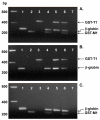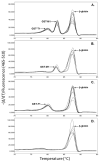Identification of the GST-T1 and GST-M1 null genotypes using high resolution melting analysis
- PMID: 22136492
- PMCID: PMC3262591
- DOI: 10.1021/tx200457u
Identification of the GST-T1 and GST-M1 null genotypes using high resolution melting analysis
Abstract
Glutathione S-transferases, including GST-T1 and GST-M1, are known to be involved in the phase II detoxification pathways for xenobiotics as well as in the metabolism of endogenous compounds. Polymorphisms in these genes have been linked to an increased susceptibility to carcinogenesis and associated with risk factors that predispose to certain inflammatory diseases. In addition, GST-T1 and GST-M1 null genotypes have been shown to be responsible for interindividual variations in the metabolism of arsenic, a known human carcinogen. To assess the specific GST genotypes in the Mexican population chronically exposed to arsenic, we have developed a multiplex High Resolution Melting PCR (HRM-PCR) analysis using a LightCycler480 instrument. This method is based on analysis of the PCR product melting curve that discriminates PCR products according to their lengths and base sequences. Three pairs of primers that specifically recognize GST-T1, GST-M1, and β-globin, an internal control, to produce amplicons of different length were designed and combined with LightCycler480 High Resolution Melting Master Mix containing ResoLight, a completely saturating DNA dye. Data collected from melting curve analysis were evaluated using LightCycler480 software to determine specific melting temperatures of individual melting curves representing target genes. Using this newly developed multiplex HRM-PCR analysis, we evaluated GST-T1 and GST-M1 genotypes in 504 DNA samples isolated from the blood of individuals residing in Zimapan, Lagunera, and Chihuahua regions in Mexico. We found that the Zimapan and Lagunera populations have similar GST-T1 and GST-M1 genotype frequencies which differ from those of the Chihuahua population. In addition, 14 individuals have been identified as carriers of the double null genotype, i.e., null genotypes in both GST-T1 and GST-M1 genes. Although this procedure does not distinguish between biallelic (+/+) and monoallelic (+/-) genotypes, it can be used in an automated workflow as a simple, sensitive, and time and money saving procedure for rapid identification of the GST-T1 and GST-M1 positive or null genotypes.
Figures




Similar articles
-
Evaluation of the association between null genotypes of glutathione-S-transferases and Behcet's disease.Arch Dermatol Res. 2006 Jan;297(7):289-93. doi: 10.1007/s00403-005-0617-1. Epub 2005 Nov 11. Arch Dermatol Res. 2006. PMID: 16283344
-
Arsenic methylation capacity, body retention, and null genotypes of glutathione S-transferase M1 and T1 among current arsenic-exposed residents in Taiwan.Mutat Res. 1997 Jun;386(3):197-207. doi: 10.1016/s1383-5742(97)00005-7. Mutat Res. 1997. PMID: 9219558
-
Chronic hepatitis B carriers with null genotypes of glutathione S-transferase M1 and T1 polymorphisms who are exposed to aflatoxin are at increased risk of hepatocellular carcinoma.Am J Hum Genet. 1996 Jul;59(1):128-34. Am J Hum Genet. 1996. PMID: 8659516 Free PMC article.
-
Lack of association between glutathione S-transferase M1 and T1 gene polymorphisms and susceptibility to preeclampsia: An updated systematic review and meta-analysis.Am J Reprod Immunol. 2020 Dec;84(6):e13303. doi: 10.1111/aji.13303. Epub 2020 Aug 1. Am J Reprod Immunol. 2020. PMID: 32658338
-
Genetic Polymorphism in Glutathione Transferases (GST): Population distribution of GSTM1, T1, and P1 conjugating activity.J Toxicol Environ Health B Crit Rev. 2009;12(5-6):389-439. doi: 10.1080/10937400903158375. J Toxicol Environ Health B Crit Rev. 2009. PMID: 20183528 Review.
Cited by
-
Additive and Interactive Associations of Environmental and Sociodemographic Factors with the Genotypes of Three Glutathione S-Transferase Genes in Relation to the Blood Arsenic Concentrations of Children in Jamaica.Int J Environ Res Public Health. 2022 Jan 1;19(1):466. doi: 10.3390/ijerph19010466. Int J Environ Res Public Health. 2022. PMID: 35010728 Free PMC article.
-
GST gene polymorphisms and the risk of colorectal cancer development.Contemp Oncol (Pozn). 2014;18(4):219-21. doi: 10.5114/wo.2014.41388. Epub 2014 May 20. Contemp Oncol (Pozn). 2014. PMID: 25258576 Free PMC article. Review.
References
-
- Oakley A. Glutathione transferases: a structural perspective. Drug Metab Rev. 2011;43:138–151. - PubMed
-
- Hayes JD, Flanagan JU, Jowsey IR. Glutathione transferases. Annu Rev Pharmacol Toxicol. 2005;45:51–88. - PubMed
-
- Mukherjee B, Salavaggione OE, Pelleymounter LL, Moon I, Eckloff BW, Schaid DJ, Wieben ED, Weinshilboum RM. Gluthahione S-transferase omega1 and omega 2 pharmacogenomics. Drug Metab Disposition. 2006;34:1237–1246. - PubMed
-
- Chowdhury UK, Zakharyan RA, Hernandez A, Avram MD, Kopplin MJ, Aposhian HV. Gluthahione-S-transferase-omega [MMA(V) reductase] knockout mice: enzyme and arsenic species concentrations in tissues after arsenate administration. Tox Appl Pharmacol. 2006;16:446–457. - PubMed
-
- Liu J, Chen H, Miller DS, Saavedra JE, Keefer LK, Johnson DR, Klaassen CD, Waalkes MP. Overexpression of glutathione S-transferase II and multidrug resistance transport proteins is associated with acquired tolerance to inorganic arsenic. Mol Pharmacol. 2001;60:302–309. - PubMed
Publication types
MeSH terms
Substances
Grants and funding
LinkOut - more resources
Full Text Sources
Molecular Biology Databases
Research Materials
Miscellaneous

